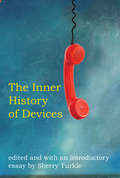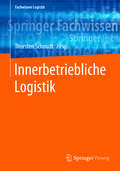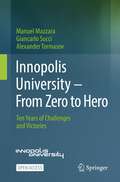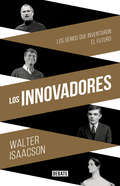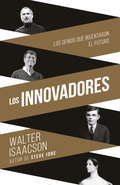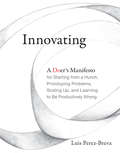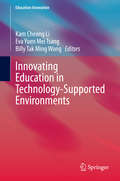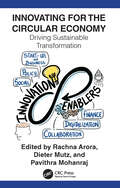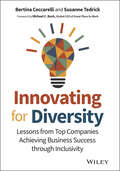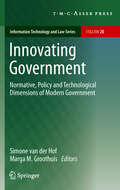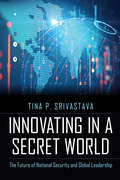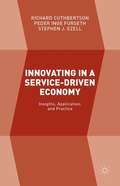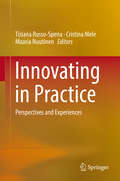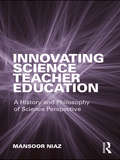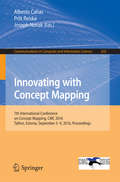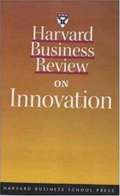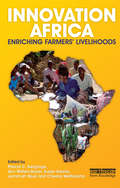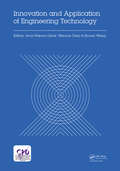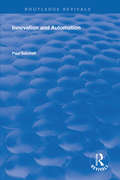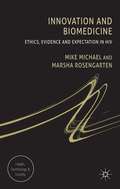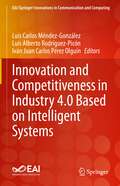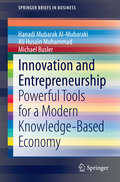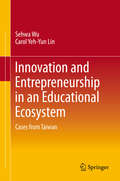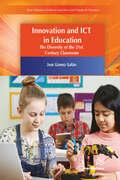- Table View
- List View
The Inner History of Devices (The\mit Press Ser.)
by Sherry TurkleMemoir, clinical writings, and ethnography inform new perspectives on the experience of technology; personal stories illuminate how technology enters the inner life.For more than two decades, in such landmark studies as The Second Self and Life on the Screen, Sherry Turkle has challenged our collective imagination with her insights about how technology enters our private worlds. In The Inner History of Devices, she describes her process, an approach that reveals how what we make is woven into our ways of seeing ourselves. She brings together three traditions of listening—that of the memoirist, the clinician, and the ethnographer. Each informs the others to compose an inner history of devices. We read about objects ranging from cell phones and video poker to prosthetic eyes, from Web sites and television to dialysis machines. In an introductory essay, Turkle makes the case for an “intimate ethnography” that challenges conventional wisdom. One personal computer owner tells Turkle: “This computer means everything to me. It's where I put my hope.” Turkle explains that she began that conversation thinking she would learn how people put computers to work. By its end, her question has changed: “What was there about personal computers that offered such deep connection? What did a computer have that offered hope?” The Inner History of Devices teaches us to listen for the answer. In the memoirs, ethnographies, and clinical cases collected in this volume, we read about an American student who comes to terms with her conflicting identities as she contemplates a cell phone she used in Japan (“Tokyo sat trapped inside it”); a troubled patient who uses email both to criticize her therapist and to be reassured by her; a compulsive gambler who does not want to win steadily at video poker because a pattern of losing and winning keeps her more connected to the body of the machine. In these writings, we hear untold stories. We learn that received wisdom never goes far enough.
Innerbetriebliche Logistik (Fachwissen Logistik)
by Thorsten SchmidtDie konkurrenzfähige Bearbeitung jedweder Kundenaufträge setzt in der Logistik die Bewegung von Gütern und Waren, die schnelle Zusammenstellung von Teilmengen aus mitunter riesigen Sortimenten und vor allem nahezu fehlerfreie, energieeffiziente Abläufe voraus. Dazu sind innerbetriebliche Logistiksysteme unabdingbar, die passgenau aus dem großen Portfolio der herstellerseitigen Lösungen zu einem integrierten Gesamtsystem geformt werden müssen. Dieses Handbuch liefert dazu sowohl die gerätetechnischen Grundlagen als auch die prozessseitigen Randbedingungen der Kommissionierung. Anhand einschlägiger Systematiken werden die diversen Ausführungen vorgestellt und deren Eigenschaften beleuchtet.
Innopolis University - From Zero to Hero: Ten Years of Challenges and Victories
by Manuel Mazzara Giancarlo Succi Alexander TormasovThis open access book describes the development of Innopolis, a young Russian university established in 2012 to focus on teaching excellence in computer science, engineering, and robotics. It reports on the problems that were faced in the first decade of its development, and the adopted solutions. It shows how the key aspects for the development of the faculty, the curricula, the university structure, and the challenge of internationalization have been successfully addressed by the university management and professors, and how the solutions are scalable for other newly founded research organizations.The book is divided in five parts: “The Beginning” describes the very early days in general, from the foundation and start-up of the university with the related processes. “The People” reports on the initial hiring of the faculty members, the selection of students, and the curriculum development. “The Activities” provide information about the creation of the single research institutions and labs, and their relation to industry. “The Future” gives an outlook on the planned internationalization and faculty strategy. Eventually, “A Visual Journey” shows a selection of photographs illustrating highlights of the whole process and the current achievements. The processes and the components described built the basis for the development of Innopolis, and many of them still have a big impact on its present and its future. The fewer mistakes are made at the beginning, the higher the probability to fully achieve the initial goals.
Los innovadores: Los genios que inventaron el futuro
by Walter IsaacsonEn una era que busca fomentar la innovación, la creatividad y el trabajo en equipo, Los innovadores es la obra que mejor muestra cómo se producen. Tras su extraordinaria biografía de Steve Jobs, el nuevo libro de Walter Isaacson cuenta la fascinante historia de las personas que inventaron el ordenador e internet; Los innovadores está destinado a convertirse en la historia definitiva de la revolución digital y en una guía indispensable para entender cómo sucede realmente la innovación. ¿Qué talentos y habilidades permitieron a algunos inventores y empresarios convertir sus ideas visionarias en realidades disruptivas? ¿De dónde vinieron esos saltos creativos? ¿Por qué algunos triunfaron y otros fracasaron? En esta magistral saga, Isaacson arranca con Ada Lovelace, la hija de lord Byron, una pionera de la programación informática en la década de 1840. Además, presenta a las extraordinarias personas quecrearon la revolución digital que nos rodea, gente como Vannevar Bush, Alan Turing, John von Neumann, J.C.R. Licklider, Doug Engelbart, Robert Noyce, Bill Gates, Steve Wozniak, Steve Jobs, Tim Berners-Lee o Larry Page. Esta es la historia de cómo funcionan sus cerebros y por qué han sido tan inventivos, pero también de cómo su capacidad para colaborar y dominar el arte del trabajo en equipo les hizo aún más creativos.
Innovadores (Innovators-SP)
by Walter IsaacsonTras su extraordinaria biografía de Steve Jobs, el nuevo libro de Walter Isaacson cuenta la fascinante historia de las personas que inventaron el ordenador e internet; Los innovadores está destinado a convertirse en la historia definitiva de la revolución digital y en una guía indispensable para entender cómo sucede realmente la innovación. ¿Qué talentos y habilidades permitieron a algunos inventores y empresarios convertir sus ideas visionarias en realidades disruptivas? ¿De dónde vinieron esos saltos creativos? ¿Por qué algunos triunfaron y otros fracasaron? En esta magistral saga, Isaacson arranca con Ada Lovelace, la hija de lord Byron, una pionera de la programación informática en la década de 1840. Además, presenta a las extraordinarias personas que crearon la revolución digital que nos rodea, gente como Vannevar Bush, Alan Turing, John von Neumann, J. C. R. Licklider, Doug Engelbart, Robert Noyce, Bill Gates, Steve Wozniak, Steve Jobs, Tim Berners-Lee o Larry Page. Esta es la historia de cómo funcionan sus cerebros y por qué han sido tan inventivos, pero también de cómo su capacidad para colaborar y dominar el ar te del trabajo en equipo les hizo aún más creativos. En una era que busca fomentar la innovación, la creatividad y el trabajo en equipo, Los innovadores es la obra que mejor muestra cómo se producen.
Innovating: A Doer's Manifesto for Starting from a Hunch, Prototyping Problems, Scaling Up, and Learning to Be Productively Wrong
by Luis Perez-BrevaInnovating is for doers: you don't need to wait for an earth-shattering idea, but can build one with a hunch and scale it up to impact.Innovation is the subject of countless books and courses, but there's very little out there about how you actually innovate. Innovation and entrepreneurship are not one and the same, although aspiring innovators often think of them that way. They are told to get an idea and a team and to build a show-and-tell for potential investors. In Innovating, Luis Perez-Breva describes another approach—a doer's approach developed over a decade at MIT and internationally in workshops, classes, and companies. He shows that to start innovating it doesn't require an earth-shattering idea; all it takes is a hunch. Anyone can do it. By prototyping a problem and learning by being wrong, innovating can be scaled up to make an impact. As Perez-Breva demonstrates, "no thing is new" at the outset of what we only later celebrate as innovation.In Innovating, the process—illustrated by unique and dynamic artwork—is shown to be empirical, experimental, nonlinear, and incremental. You give your hunch the structure of a problem. Anything can be a part. Your innovating accrues other people's knowledge and skills. Perez-Breva describes how to create a kit for innovating, and outlines questions that will help you think in new ways. Finally, he shows how to systematize what you've learned: to advocate, communicate, scale up, manage innovating continuously, and document—“you need a notebook to converse with yourself,” he advises. Everyone interested in innovating also needs to read this book.
Innovating Education in Technology-Supported Environments (Education Innovation Series)
by Kam Cheong Li Billy Tak Ming Wong Eva Yuen Mei TsangThis book explores a broad range of innovations in education, such as flipped classrooms, the educational use of social media, mobile learning and educational resources. It also includes theoretical discussions and practical applications related to the use of augmented reality and educational technologies for improving students’ engagement and facilitating their future studies and careers. Featuring case studies and practical applications illustrating the effectiveness of new modes of education in which the latest technologies and innovations are widely used in the global context, the book helps readers develop their awareness of the related insights and implications, in order to deepen their understanding and stimulate critical thinking as to how new technologies have made learning and teaching easier in different educational settings.
Innovating for The Circular Economy: Driving Sustainable Transformation
by Rachna Arora, Dieter Mutz, and Pavithra MohanrajSystemic change is required to move to a circular economy (CE) model which can meet the demands of a growing population in a manner that is decoupled from resource use and waste generation. This book takes a deep dive into the innovation aspect of the circular economy (CE), with a specific focus on India as a geography, where the transformation to a circular economy is underway. How a developing country like India is tackling the complexities of the transformation and creating innovative solutions is showcased in this book through many practical examples and inspirational case studies. The book lays out the foundations for mainstreaming resource efficiency (RE)/CE in India, and covers innovation led by businesses and start-ups, along with the innovative policies, financing, and collaborative models required to spur and accelerate circular economy approaches, while also providing linkages to the international context. Features: Provides insight into the role of innovation in the circular economy transition Helps to develop and facilitate adoption of resource-efficiency policy and strategy with particular focus on key resource sectors and waste streams Treats the circular economy as a holistic approach across the entire lifecycle, and places emphasis on upstream interventions and systems change Examines the current context of COVID-19 and its impact on circular economy models and practices Touches upon how the EU-based approach was adapted and contextualised significantly to work in the unique Indian landscape This book is aimed at students, researchers, and professionals engaged in the domains of circular economy, sustainability, business innovation, environmental studies, natural resources management, and environmental and resource conservation policy.
Innovating for Diversity: Lessons from Top Companies Achieving Business Success through Inclusivity
by Bertina Ceccarelli Susanne TedrickDiscover what business visionaries on the frontiers of diverse and equitable hiring are doing to drive change in their organizations In Innovating for Diversity: Lessons from Top Companies That are Disrupting Old Practices to Achieve Inclusivity, Equity and Business Success, renowned Diversity, Equity, and Inclusion (DEI) and tech specialists Bertina Ceccarelli and Susanne Tedrick reframe the DEI discussion and move it beyond a human resources issue. While it's well established that diverse teams help to advance innovation, the authors explain how principles of innovation can be applied to building highly effective and sustainable diversity, equity and inclusion (DEI) practices embraced by executives across an organization. You'll be inspired by leaders at top companies who identified root causes of limited DEI progress and created smart, bold solutions for increasing representation, developing future talent, and advancing the careers of people often overlooked. In the book, you'll also find: Introductions to the people and companies who have innovated their approaches to diverse hiring, retention, and advancement, and enjoyed pronounced impact on their bottom lines Profiles of committed leaders driving the change towards a more diverse and inclusive workforce Strategies for breaking down the cultural and organizational barriers in companies that remain in place and prevent transformative change A critical resource for senior-level business professionals, managers, and executives, Innovating for Diversity will also prove to be invaluable for people seeking to build their careers from the ground up.
Innovating Government
by Marga M. Groothuis Simone van der HofThe aim of this book is to analyze four dimensions of innovating government and the use of new technologies: legal, ethical, policy and technological dimensions. By joining authors from a diversity of backgrounds (law, ethics, public administration, political science, sociology, communications science, information science, and computer science) in one book, readers (academics, policy makers, legislators and others) are confronted with a variety of disciplinary perspectives on persistent themes, like privacy, biometrics, surveillance, e-democracy, electronic government, and identity management, that are central to today's evolution of new modes of modern government.
Innovating in a Secret World: The Future of National Security and Global Leadership
by Tina P. SrivastavaOur national security increasingly depends on access to the most sophisticated and advanced technology. Yet the next time we set out to capture a terrorist leader, we may fail. Why? The answer lies in a conflict between two worlds. One is the dynamic, global, commercial world with its thriving innovations. The other is the world of national security, in which innovation is a matter of life or death. The conflict is about secrecy.Innovating in a Secret World is a detailed examination of the U.S. government and innovation landscapes and of the current trends in often secret national security–related research and development (R&D). Based on case studies, detailed research, and interviews with executives at Fortune 500s, startup entrepreneurs, and military directors and program managers, this accessible and timely book is a must-read. Tina P. Srivastava evaluates whether the strategy of technology innovation in the world of national security leaves certain innovations behind or unintentionally precludes certain classes of innovators from participating. She identifies the unintended consequences and emergent behaviors of this conflict. This examination unfolds in a complex, dynamic system that includes the legal framework in which technology innovation must exist. For more than a decade Srivastava has been on the front lines of cutting-edge technology innovation. She suggests focusing on an emerging class of R&D strategy called “open innovation”—a strategy that broadens participation in innovation beyond an individual organization or division traditionally assigned to perform R&D activities. Through compelling stories of commercial and early government applications, she shows how open technology innovation strategies can enable, accelerate, and enhance technology innovation. Successful incorporation of open innovation into the previously closed U.S. government R&D landscape can yield profound benefits to both national security and global leadership.
Innovating in a Service-Driven Economy: Insights, Application, and Practice
by Richard Cuthbertson Peder Inge Furseth Stephen J. EzellInnovating in a Service-Driven Economy.
Innovating in Practice
by Tiziana Russo-Spena Cristina Mele Maaria NuutinenThe purpose of the book is to devise an alternative conceptual vocabulary for studying innovation by stressing the role of social, contextual and cultural perspectives. This vocabulary is drawn on a service and on sociological perspectives on innovation based on the ontological assumption that innovation is a value co-creation matter and that it takes place in a reality that is multiple, constructed and socially embedded. The aim is to tackle key issues such as social construction, service innovation, knowledge and learning processes, value (co) creation, innovating and innovation activities networking and collaborative innovation.
Innovating Science Teacher Education: A History and Philosophy of Science Perspective
by Mansoor NiazHow teachers view the nature of scientific knowledge is crucial to their understanding of science content and how it can be taught. This book presents an overview of the dynamics of scientific progress and its relationship to the history and philosophy of science, and then explores their methodological and educational implications and develops innovative strategies based on actual classroom practice for teaching topics such the nature of science, conceptual change, constructivism, qualitative-quantitative research, and the role of controversies, presuppositions, speculations, hypotheses, and predictions. Field-tested in science education courses, this book is designed to involve readers in critically thinking about the history and philosophy of science and to engage science educators in learning how to progressively introduce various aspects of ‘science-in-the-making’ in their classrooms, to promote discussions highlighting controversial historical episodes included in the science curriculum, and to expose their students to the controversies and encourage them to support, defend or critique the different interpretations. Innovating Science Teacher Education offers guidelines to go beyond traditional textbooks, curricula, and teaching methods and innovate with respect to science teacher education and classroom teaching.
Innovating with Concept Mapping
by Alberto Cañas Priit Reiska Joseph NovakThis book constitutes the refereed proceedings of the 7th International Conference on Concept Mapping, CMC 2016, held in Tallinn, Estonia, in September 2016. The 25 revised full papers presented were carefully reviewed and selected from 135 submissions. The papers address issues such as facilitation of learning; eliciting, capturing, archiving, and using expert knowledge; planning instruction; assessment of deep understandings; research planning; collaborative knowledge modeling; creation of knowledge portfolios; curriculum design; eLearning, and administrative and strategic planning and monitoring. "
Innovation: A Systems Approach (Analytics and Control #27)
by Adedeji B. BadiruInnovation: A Systems Approach Subject Guide: Engineering-Industrial & Manufacturing It is a systems world. This concise book uses a systems-based approach to show how innovation is ubiquitous in all facets of endeavors, including business, industry, government, and academia. The systems approach facilitates process design, evaluation, justification, and integration. This book explicitly highlights the crucial role of integration in any innovation project. It presents conceptual and operational definitions of innovation. Emphasis is placed on the context related to the theme of systems thinking. Features Covers the intrinsic basis for innovation from a systems perspective Describes the use of the DEJI systems model for actuating innovation Highlights the role of humans in the innovation loop Provides guidance for innovation project management Presents a case example of linking quality and innovation Introduces the Umbrella Theory of Innovation
Innovation Africa: Enriching Farmers' Livelihoods
by Pascal C. Sanginga Ann Waters-Bayer Susan Kaaria Jemimah Njuki Chesha WettasinhaAgricultural research, extension and education can contribute greatly to enhancing agricultural production in a sustainable way and to reducing poverty in the developing world, but achievements have generally fallen short of expectations in Africa. In recent years, growing economic and demographic pressures - coupled with the entry of new market forces and actors - have created a need and an opportunity for more interactive approaches to development. Understanding the existing innovation processes, recognizing the potential for catalysing them and learning how to support joint innovation by different groups will be the key to success. This book covers new conceptual and methodological developments in agricultural innovation systems, and showcases recent on-the-ground experiences in different contexts in Africa. The contributions show how innovation is the outcome of social learning through interaction of individuals and organizations in both creating and applying knowledge. It brings examples of how space and incentives have been created to promote collaboration between farmers, research, extension and the private sector to develop better technologies and institutional arrangements that can alleviate poverty. In 25 broad-ranging chapters the book reflects cutting-edge thinking and practice in support of innovation processes in agriculture and management of natural resources.
Innovation and Application of Engineering Technology: Proceedings of the International Symposium on Engineering Technology and Application (ISETA 2017), May 25-28, 2017, Montreal, Canada
by Avon Pekano Oscar Wenxue Chen Shuren WangInnovation and Application of Engineering Technology contains the proceeding of International Symposium of Engineering Technology and Application Convocation (ISETA 2017, 25-28 May 2017, Montreal, Canada). The Symposium provided an international forum for discussion and communication of engineering technology and application of Civil and Environmental Engineering, Mining Engineering, Risk and Occupational Engineering and other fields related to engineering. Sponsored by Concordia University, International Joint Research Laboratory of Henan Province for Underground Space Development, Henan Polytechnic University and IJSS, Innovation and Application of Engineering Technology will be useful for researchers, engineers and graduate and Ph.D. students in related Engineering fields.
Innovation and Automation (Routledge Revivals)
by Paul SatchellFirst published in 1998, this book links the forces of innovation and automation positively by shifting the focus on human-machine interactions from the current, technology-centred approach, to one where sharing is evolved and creativity is no longer suppressed. It provides a unique way of understanding innovation in organisations, by using an environmental interaction approach to understand creativity and its translation into innovatory behaviour. The current dampening of creativity in organisations is made meaningful by explaining organisational behaviour in terms of rituals. The author succinctly assembles the current evidence that the prevailing technology-centred approach to automation is in part responsible for the inability of humans to be creative in work situations. Many of the behavioural constraints necessary for this type of automation paralyse the translation of creativity into innovatory behaviour. In producing an antidote to the technology-centred approach, he moves beyond current human-centred thinking, to an approach where humans and machines share by using the same processes that underlie the sharing between humans. This sharing-centred approach to automation is explained and illustrated. Throughout the book the current state of human-machine interactions is illustrated with vignettes from aviation, medicine and from organisations. The book also discusses three pictures of future human-machine interactions of the flightdeck, in primary care medical practice, and in boardrooms of major organisations. The main readership includes all who are interested in innovation and organisational development, especially in the technology based industries and services such as healthcare, transportation, manufacturing and information systems; it provides essential new ideas for senior executives, strategic consultants, specialists in organisational behaviour and human resources, members of regulatory agencies and other government facilities, and academicians and researchers.
Innovation and Biomedicine
by Mike MichaelWith its focus on the offshore randomized control trials of a Pre-Exposure Prophylactic pill (PrEP) for preventing HIV infection, the volume develops a sustained analysis of the complex, virtual and topological dimensions of the expectations, ethics and evidence that surround the innovation of PrEP.
Innovation and Competitiveness in Industry 4.0 Based on Intelligent Systems (EAI/Springer Innovations in Communication and Computing)
by Luis Carlos Méndez-González Luis Alberto Rodríguez-Picón Iván Juan Carlos Pérez OlguínThis book presents a series of applications of different techniques found in Industry 4.0 with relation to productivity, continuous improvement, quality, decision systems, software development, and automation systems. The techniques used throughout this book allow the reader to replicate the results obtained towards different types of companies that wish to undertake in the new era of the digital industrial revolution. This book can also help students from different areas of engineering to understand how the use of new technologies is applied to solve current relevant problems and how they give the possibility of constant innovation in the different industrial sectors. This is accomplished through the analysis of illustrative case studies, descriptive methodologies and structured insights that are provided through the different considered techniques.
Innovation and Entrepreneurship
by Hanadi Mubarak Al-Mubaraki Ali Husain Muhammad Michael BuslerIn this book, Hanadi Mubarak, Ali Husain and Michael promote the concept of innovation incubators from a business-management perspective. The book provides a comprehensive roadmap for the development of new economies based on technology, as well as value added in technology transfer, innovation development and an entrepreneurial climate. Many books on innovation and entrepreneurship take a theoretical approach, presenting a selection of examples that may not reflect reality. However, this compendium of innovation and entrepreneurship case studies is based on the practical experience of executives and managers regarding the undertaking of projects within their industry and company. It is this practical approach, emphasizing enterprise-wide projects as a consequence of the current economic reality that differentiates this book from conventional texts on innovation and entrepreneurship. This investigation uses successful international case studies based on models in developed and developing countries. It argues that innovation incubators must be adopted by Arab countries to support diversification of their economies, the commercialization of new technologies, job creation and foster an entrepreneurial climate. The book presents research and case studies, which provide new insights into practices for undertaking projects that both executive and project managers will find interesting and useful for the advancement of their enterprises, particularly in the area of innovation and entrepreneurship.
Innovation and Entrepreneurship in an Educational Ecosystem: Cases from Taiwan
by Carol Yeh-Yun Lin Sehwa WuThis book reports on 12 education innovation cases in Taiwan and focus particularly on an ecosystem to demonstrate innovation as a competitive advantage and requires an ecosystem to be sustainable in virtually all disciplines. It also covers the trend of education innovation in many countries, with “education entrepreneurship” being the frequently used description. The 12 educators highlighted here are even more entrepreneurial than many businesspeople. Generally, schools are required to follow certain rules, especially the public schools. Accordingly, the book also describes how these education entrepreneurs have innovatively created a fostering environment under challenging constraints to facilitate the success of students, teachers, and even the local community. Six of the cases involve school-based innovation, while the other six focus on student-based innovation. Their stories provide valuable insights for all companies seeking to become more innovative in a resource-constrained setting.
Innovation and ICT in Education: The Diversity of the 21st Century Classroom
by José Gómez GalánThe adequate integration of information and communication technologies (ICT) in educational and training processes is one of the biggest current challenges in education. The classroom of the present is very different from just a few decades ago, new technological tools are completely transforming its characteristics and activities. This internationally authored book offers a timely, effective and practical vision of this new educational scenario.The book takes a multidisciplinary approach in looking at the problems and possible solutions that are faced by the educational professional of the 21st century when, by necessity or obligation, they face the use of ICT in their daily tasks. Divided into two parts, one theoretical and another practical, this book offers the highlights of the most important lines of research that are being developed today in educational technology, and importantly presents the innovations which have had the most impact over recent years. From the profound transformations in the physical classroom to everything that involves new virtual scenarios, where online teaching requires innovative strategies and training processes, this book describes the diverse scenarios that ICT has generated and will continue to generate in the field of education. It presents a new and a very different type of education that can be adapted to the needs of the citizen of the digital society.
